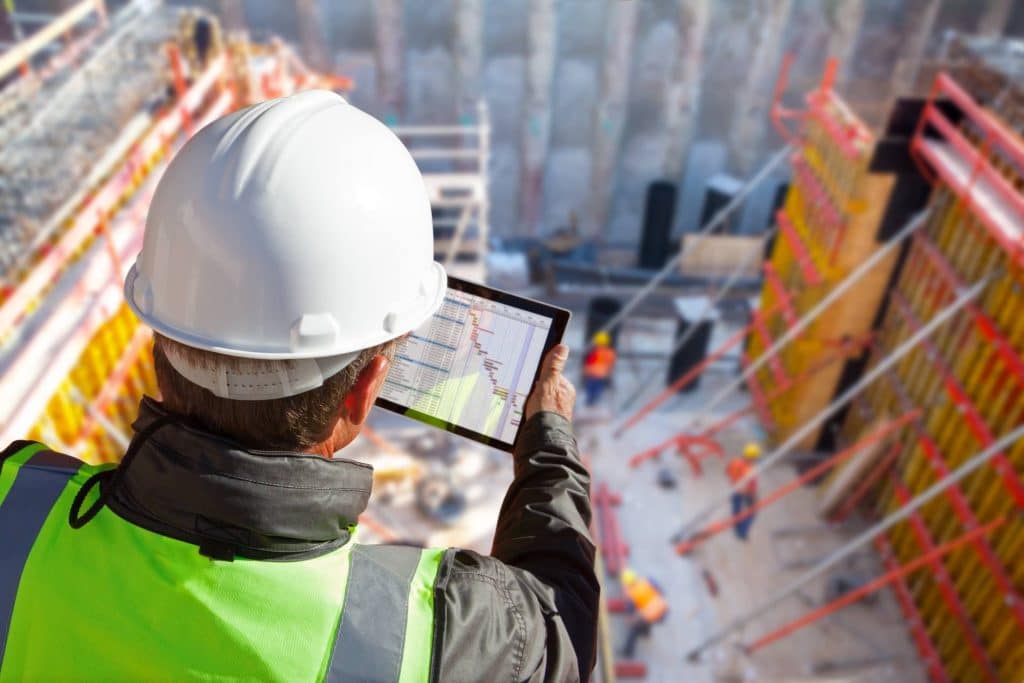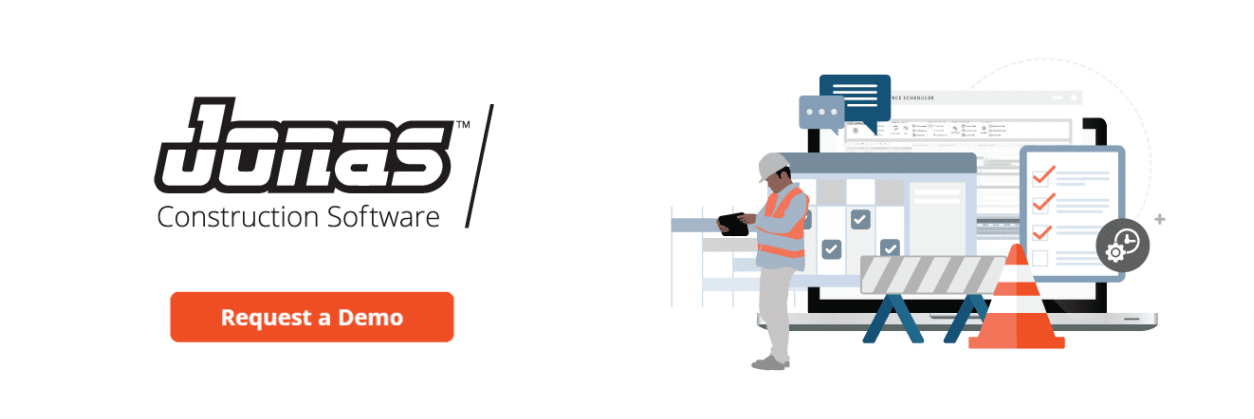Last Updated on February 4, 2024

After a turbulent start to a decade that was marked by a lot of uncertainty for construction companies across the globe, where does the construction industry stand as we enter a new year in 2022?
In this article, we’re taking a look back at the important trends that shaped the construction industry in 2021 and we’re looking forward to the new trends on the horizon for 2022.
As the industry continues to evolve, construction companies are eager to take advantage of the latest trends and innovations in order to stay ahead in an increasingly competitive landscape. To help your construction business overcome common industry challenges and stay agile in a time of industry reemergence, we’ve compiled the must-know construction industry trends and key insights on how to respond to them in the coming years.
The 2021 Year-End Wrap Up for the Construction Industry
Before we look onwards at the trends to look out for in 2022, let’s take a look back at the trends that arose from 2021— a year marked by incredible resilience and innovation in the construction industry. Despite challenges like economic uncertainty and tightened regulations, the industry continued to adapt and find new ways to grow and evolve.
Hiring Surge

The surge in construction job openings is a trend that was exceptionally prevalent in 2021. Many construction firms were in need of skilled labor in order to complete new construction projects, yet finding workers to fill those positions was a common challenge.
This construction industry trend is expected to continue in the coming years. According to recent research from the Home Builders Institute, the number of construction workers required to keep up with demand is approximately 740,000 new workers per year through 2024.
More Technology Integration
It’s no question that the COVID-19 pandemic has had a significant impact on accelerating technology adoption and innovation in the construction industry. The following construction technologies played an important role in increasing productivity and reducing inefficiencies for construction companies in 2021.
Mobile Technology
In 2021, the increased adoption of mobile technology played a significant role in improving the flow of information between offices and job sites. With mobile technology, field workers are able to access the tools and information they need to get the job done via their mobile devices while also engaging in real-time data collection and transmission for better record keeping and collaboration.
VR/Augmented Reality Technology
VR and AR technology has really started to transform the world of construction in 2021. Construction firms have adopted these technologies for purposes such as enhancing safety, selecting the right materials for construction projects, developing complex designs, and even giving stakeholders accurate renditions of their upcoming projects. Certain economists estimate that the latest VR technologies could reduce construction costs by around 90% (Builder).
Drones
2021 has seen the beginning of the ways in which drone usage is changing construction industry operations. Drones have already been used to survey land, collect and report data on construction sites, protect job sites from theft and vandalism and provide job site inspections to identify safety hazards.
Construction Management Software

In 2021, many construction businesses have seen the immense benefits of adopting construction management software. From streamlined business processes to increased profitability, construction firms across the world have found a fully integrated and automated construction management solution to be their key to getting ahead.
Increased Safety Measures
Worker safety was a key concern in the construction industry in 2021 amidst the ongoing COVID-19 pandemic. In order to protect construction workers and make construction sites as safe as possible, construction companies had to comply with a significant number of regulations that differed depending on their locations. This compliance included measures such as providing personal protective equipment or enhancing cleaning protocols.
Increased Off-Site and Pre-Construction Practices
In both 2021 and the past few years, there has been an offsite construction revolution. Offsite construction is the practice of moving a large portion of construction work off of the construction site and into indoor factory settings. The benefits of this method include reduced risk, lower costs, and improved working environments. This approach is now being adopted for larger-scale projects as an alternative to traditional construction.
Rising Costs of Wages and Materials
The past year was particularly costly for construction companies due to rising material costs and worker wages. The rising prices of building materials were caused by factors such as tariffs and trade issues, environmental regulations, and changing demands. On the other hand, wages were an increased cost because of the limited talent pool. Many construction companies had to increase wages for their current staff in order to avoid employee turnover.
Implementation of Big Data
In order to gain data-driven insights, solve big problems and make informed decisions, many construction companies have started to leverage big data in the construction process. Big data has had a significant impact on the companies that have started to adopt it, helping them complete projects more efficiently and provide more accurate bids.
Key Construction Industry Trends for 2022 to Focus on and How to Respond
As we embark on a new year in 2022, it’s important to both reflect on the past and look towards the future so you can be fully prepared to leverage upcoming trends and learn from past challenges. Now that we’ve recapped the 2021 trends, here are the construction industry trends to watch for in 2022.
Continued Focus on Safety Measures With a Focus on Technology
In 2022, many experts are anticipating a continued emphasis on protecting the safety of construction workers. As we discussed previously, new technologies like virtual reality and augmented reality have started to make waves in the construction industry. Going forward, these technologies are set to make a real impact on improving workplace safety standards. Using drones or computer prototypes will be the key to identifying potential project hazards before incidents occur. Additionally, AR and VR technologies can help you train new workers before they enter high-risk scenarios on the job site.
The Rise in Modular Construction Continues
As previously discussed, 2021 was marked by a trend towards more off-site construction rather than traditional construction where all the work is performed on the job site. Modular construction involves constructing a building off-site in modules with the intention of putting these modules together onsite. With proven benefits such as cost savings, time savings, and the absence of weather delays, it’s no question that the modular construction trend will continue in the coming years.
If you’re considering making the switch to modular construction, keep in mind that this method also comes with its own challenges: mass production can limit variety and the transportation of the modules can be risky and costly. Although modular construction could be a real gamechanger for your company, it’s still important to weigh the pros and cons of rising trends.
Retaining and Keeping Skilled Staff

Just like in 2021, labor shortages are expected to persist into 2022. Although it will be important for construction companies to find new ways to recruit skilled workers, it will be even more important to retain the skilled staff that you already employ.
In a survey from The Associated General Contractors of America, 62% of surveyed construction firms said that they are actively increasing wages and benefits in order to attract and retain employees. To avoid losing your skilled workers to other firms, it will be essential to evaluate your compensation packages and ensure they are at least up-to-par with or exceeding industry standards.
Technology Integration is Here to Stay

In 2022, the construction industry can expect to see greater adoption and wider usage of existing technologies and the introduction of new construction technologies.
Digitalization of the Field and Office
According to a report from Mckinsey Global Institute, construction companies that invest in digitalization while embracing advanced automation and innovative materials could see a 50-60% productivity increase.
When it comes to digitalization, there are many opportunities to embrace this trend both in the field and in the office. For example, with a construction management software solution like Jonas Construction, you can eliminate hand-written employee time cards by empowering employees to enter their time from the field on their mobile devices. You can also provide your customers with a self-service portal where they can manage all aspects of their jobs or work orders.
Wearable Technology
Smart wearables have the potential to make a significant impact on the construction industry in terms of worker safety and efficiency. These technologies can collect, transmit and store information about each worker’s whereabouts, nearby safety hazards, biometric data, and more. The scope of wearable technology has evolved significantly in recent years and this technology is set to really take off in 2022.
From smart helmets with 3D visual overlays to bionic suits that can handle heavy materials with ease, there are many exciting wearable technology innovations on the horizon.
BIM
BIM (building information modelling) is a revolutionary building information technology that allows you to generate 3D models of complex projects and digital representations of projects at various stages of their lifecycles. Although BIM technology is still relatively new, 69% of large contractors that use BIM report using BIM on most of their projects (Dodge Data & Analytics report). In 2022, the industry can expect even more contractors to adopt BIM technology for an increasing number of projects.
Robots in the Labor Force
In response to the labor shortage, robotics technology is becoming increasingly prevalent on construction sites. Autonomous robots help construction companies handle more menial, repetitive tasks so they can use their workers more efficiently.
Additionally, robots have also been shown to increase safety and reduce construction-related injuries. Whereas a human body cannot handle performing the same task 24 hours a day, robots are immune to this stress. If you’re having trouble with hiring workers to complete your construction project, an investment in robotics could be the answer.
How Jonas Construction Software Can Help You Stay Ahead of Industry Trends
Now that you have a better understanding of the trends on the horizon for the construction industry, it’s a good time to evaluate your own business. Where do you stand in regards to the adoption of new technologies and innovations? Are you prepared to take on the challenges that continue to affect the industry?
If you feel like you’re falling behind, we can help. In a time of rapid growth and innovation, making the switch to a fully-integrated construction management software is the best way to stay on top of the trends and ensure the ongoing success of your business.
Jonas Construction Software is a fully integrated construction management solution that can help you increase your productivity, boost your profitability, reduce your manual errors, improve your customer service and employee satisfaction, and much more! Contact us today or request a demo to see for yourself how Jonas can help you stay on top in 2022.







